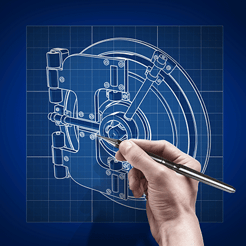An overview of Computer Aided Design
Computer aided design (CAD) started around the mid 1970’s when systems began to provide more capability than to reproduce manual drafting with electronic drafting.
Now, CAD is used throughout many industries for the design of a part, a sub-assembly, or an entire product. Designs can include technical drawings with symbol based representations, visualisation, 3D rendering, and simulation.
The software can be used to create widgets, iPhone’s, buildings, cars, and pretty much everything that surrounds us today. With the technology advancing, designers are now able to take their product from concept, through the manufacturing process to the finished product accurately and quicker than before.
Whether you are just starting out with CAD or you have been a frequent user for many years, we’ve put together 3 CAD design tips for creating flawless drawings to help reduce errors you could encounter along the way;
Create drawing standards… and stick to them
Produce a thorough checklist of what you need on each type of drawing. Creating a checklist will reduce the amount of errors which could be made in the design process. Print off a collection of your drawings to help create a list of steps and things you will need for that type of drawing.
It doesn’t hurt to include general information such as how you fill out your title block, basic annotations for each sheet, notes, details, etc.
It’s important you apply this to every project and stick to the list.
Things to look out for when creating CAD drawings:
- All drawings should be created to British Standard 8888
- Avoid double dimensioning i.e. dimensioning the same feature in two ways on the same drawing
- Do not dimension to hidden lines, use sections and dimension to solid lines
- Use cross hair centre marks on holes to dimension too – not just a line going perhaps somewhere near.
- Don’t dimension on the part – place dimensions away from the part
- Neatly stagger stacked dimensions
- Be consistent – especially with text font and sizes on tolerances and dimensions
- When sectioning views use a clear hatch type and scale – often hatching can confuse features, such as holes, if badly selected.
- Datums – carefully select and be consistent.
- Avoid sequential dimensioning as this will cause tolerance build up
- Tolerances – unnecessarily tight and the cost of manufacture increases – too slack and the part may not fit / perform its intended function.
Show off features with images

The more complicated a drawing is, the harder it can be for others to understand. Use images, symbols and numbers to explain the features of your product part that may not be clear to others. You can use different angles and views to show off that feature.
Quality Checks
Quality checks should be performed by at least 2 people.
Print out your drawings and go through your checklist thoroughly ensuring you mark anything that’s wrong. If you are missing information, write, sketch or draw it in. As long as the items you found missing get on to your drawing, everything should be fine. Once you have completed your first check and amended your errors, repeat the process until you are happy for it to be checked by another person.
Things to look out for
- Can I make this?
- Do I understand the shape?
- Is there enough information for manufacturers e.g. dimensions, finish, material, etc.
- On assembly drawings – can I find every part in the parts list which makes this assembly?
Also, do I have parts left over that are not shown on the assembly drawing?
Designing for extrusion?
We've put together articles to help provide guidence and assistance for those who are designing for extrusion, check them out for more tips and tricks;
How we can help
If you require design assistance, get in touch with our in house product designer here or if you have a drawing you would like a 3D print of, upload your drawing here or use the button below to order your free 3d printed prototype.
